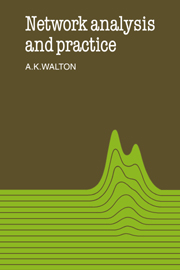Book contents
- Frontmatter
- Contents
- Preface
- 1 Electric charge, field and potential
- 2 Electric current, resistance and electromotive force
- 3 Direct-current networks
- 4 Capacitance, inductance and electrical transients
- 5 Introduction to the steady-state responses of networks to sinusoidal sources
- 6 Transformers in networks
- 7 Alternating-current instruments and bridges
- 8 Attenuators and single-section filters
- 9 Multiple-section filters and transmission lines
- 10 Signal analysis of nonlinear and active networks
- 11 Fourier and Laplace transform techniques
- 12 Filter synthesis
- Mathematical background appendices
- Problems
- Answers
- Solutions
- Index
7 - Alternating-current instruments and bridges
Published online by Cambridge University Press: 05 June 2012
- Frontmatter
- Contents
- Preface
- 1 Electric charge, field and potential
- 2 Electric current, resistance and electromotive force
- 3 Direct-current networks
- 4 Capacitance, inductance and electrical transients
- 5 Introduction to the steady-state responses of networks to sinusoidal sources
- 6 Transformers in networks
- 7 Alternating-current instruments and bridges
- 8 Attenuators and single-section filters
- 9 Multiple-section filters and transmission lines
- 10 Signal analysis of nonlinear and active networks
- 11 Fourier and Laplace transform techniques
- 12 Filter synthesis
- Mathematical background appendices
- Problems
- Answers
- Solutions
- Index
Summary
Alternating-current meters
Any system that measures direct current or potential difference can be adapted to measure the corresponding alternating quantity by inserting a rectifying circuit in front of it. The term rectification refers to rendering the alternating current or potential difference unidirectional through removing or reversing it whenever it is one of its two possible polarities. It should be clear that, with sufficient damping, a direct measuring system will respond to the mean level of a rectified alternating input. Removal of alternating half-cycles is termed half-wave rectification. Reversal of alternate halfcycles is described as full-wave rectification and is illustrated in figure 7.1(a) for a sinewave. The neatest and most popular way of implementing fullwave rectification is by means of four diodes arranged in a Wheatstone bridge formation as shown in figure 7.1(b). Understandably, this form of circuit is called a bridge rectifier. As explained in section 2.3, a diode is a device that presents a very low resistance to current flow when appreciable potential difference of one sign, known as forward, is applied while it presents a very high resistance to current flow when appreciable potential difference of the opposite sign, known as reverse, is applied. In the case of modern silicon P–N junction diodes, appreciable here means >0.6 V. The direction of the arrow head in the circuit symbol for the diode indicates the direction of easy current flow.
- Type
- Chapter
- Information
- Network Analysis and Practice , pp. 144 - 166Publisher: Cambridge University PressPrint publication year: 1987



